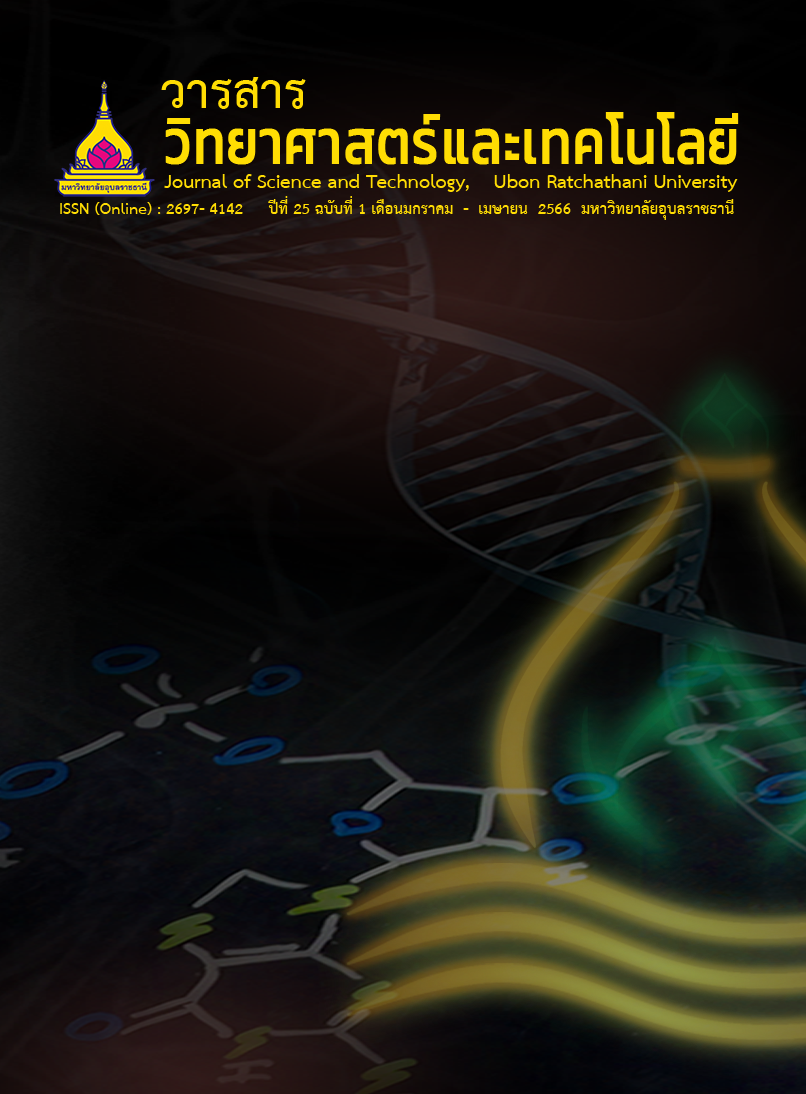การปรับปรุงเงื่อนไขการดำเนินงานในการอบแห้งเตาหลอมด้วยการดำเนินการอย่างวิวัฒนาการ
Main Article Content
บทคัดย่อ
บทความวิจัยนี้มีวัตถุประสงค์เพื่อปรับปรุงเงื่อนไขการดำเนินงานในการอบแห้งเตาหลอมอุ่นน้ำอลูมิเนียมที่เกิดรอยแตกร้าวภายในเตาด้วยการดำเนินการอย่างวิวัฒนาการ โดยทำการทดลองแบบแฟคทอเรียลสมบูรณ์ 2 ระดับ 2 ปัจจัยรวมจุดกึ่งกลาง ซึ่งใช้เป็นจุดเริ่มต้นในการทดลองที่อุณหภูมิ 760 องศาเซลเซียส ระยะเวลาอบแช่ 48 ชั่วโมง แล้วเปลี่ยนแปลงระดับปัจจัยไปทีละน้อยขณะกำลังดำเนินการผลิตตามปกติอย่างต่อเนื่อง ผลการวิจัยพบว่า เงื่อนไขการดำเนินงานที่เหมาะสมอยู่ที่อุณหภูมิ 780 องศาเซลเซียส ระยะเวลาในการอบแช่ 56 ชั่วโมง ดีกว่าเงื่อนไขการดำเนินงาน ซึ่งปรับปรุงโดยฝ่ายผลิตที่อุณหภูมิ 820 องศาเซลเซียส ระยะเวลาในการอบแช่ 24 ชั่วโมง เพราะมวลน้ำทิ้งจากเตาหลอมเพิ่มขึ้นจาก 52 กิโลกรัม เป็น 74.8 กิโลกรัม และความชื้นสัมพัทธ์ภายในเตาหลอมลดลงจาก 10% เหลือ 4.20% นอกจากนี้ยังดีกว่าเงื่อนไขการดำเนินงานเดิมก่อนปรับปรุงที่อุณหภูมิ 700 องศาเซลเซียส ระยะเวลาในการอบแช่ 72 ชั่วโมง เพราะระยะเวลาในการอบแช่ลดลงจาก 72 ชั่วโมง เหลือ 56 ชั่วโมง และไม่พบปัญหารอยแตกร้าว โดยมวลน้ำทิ้งจากเตาหลอมมีค่าใกล้เคียงกับเกณฑ์มาตรฐานที่ 76 กิโลกรัม และความชื้นสัมพัทธ์ภายในเตาไม่เกิน 7%
Article Details

อนุญาตภายใต้เงื่อนไข Creative Commons Attribution-NonCommercial-NoDerivatives 4.0 International License.
บทความที่ได้รับการตีพิมพ์เป็นลิขสิทธิ์ของ วารสารวิทยาศาสตร์และเทคโนโลยี มหาวิทยาลัยอุบลราชธานี
ข้อความที่ปรากฏในบทความแต่ละเรื่องในวารสารวิชาการเล่มนี้เป็นความคิดเห็นส่วนตัวของผู้เขียนแต่ละท่านไม่เกี่ยวข้องกับมหาวิทยาลัยอุบลราชธานี และคณาจารย์ท่านอื่นๆในมหาวิทยาลัยฯ แต่อย่างใด ความรับผิดชอบองค์ประกอบทั้งหมดของบทความแต่ละเรื่องเป็นของผู้เขียนแต่ละท่าน หากมีความผิดพลาดใดๆ ผู้เขียนแต่ละท่านจะรับผิดชอบบทความของตนเองแต่ผู้เดียว
เอกสารอ้างอิง
Thailand Automotive Institute (TAI). 2018. Material Technology Study Project for Electric Vehicle Manufacturing. Samut Prakan: TAI. (in Thai)
Collot, J. 2001. Review of new process technologies in the aluminum die-casting industry. Materials and Manufacturing Processes. 16(5): 595-617.
Pinrath, N. 2014. Mechanical Properties Testing of A356 Aluminum Alloys Produced by Horizontal Indirect Squeeze Casting Process. M.Eng. Thesis, Suranaree University of Technology. (in Thai)
Jenkins, J., Piper, P. and Proctor, J. 2011. Important considerations for refractory dryouts, startups & shutdowns. In: Proceedings of 2011 Sulfur Recovery Symposium, 13-16 September 2011. Vail, Colorado, USA.
Zabolotskii, A.V. and et al. 2011. Mathematical modeling of the movement of moisture in refractory concrete and gunning bodies during drying. Refractories and Industrial Ceramics. 57(6): 578-584.
Nikiforov, A.S. and et al. 2020. Refractory material moisture metering when heating high-temperature units. Refractories and Industrial Ceramics. 61(2): 224-227.
Pietraszek, J., Radek, U. and Goroshko, A.V. 2020. Challenges for the DOE methodology related to the introduction of Industry 4.0. Production Engineering Archives. 26(4):190-194.
Wass, N. and Czupryna, S.W. 2015. Overcoming Process Improvement Obstacles: A JMP/EVOP Case Study. https://community.jmp.com/t5/ Discovery-Summit-2015/Overcoming-Process-Im provement-Obstacles-A-JMP-EVOP-Case-Study/ta-p/22209. Accessed 14 October 2021.
Hahn, G.J. 1987. Process Improvement Through Simplex EVOP. https://paperzz.com/doc/6814 173/process-improvement-through-simplex-evop. Accessed 14 October 2021.
Ginting, E., Tambunan, M.M. and Syahputri, K. 2018. Application study of evolutionary operation methods in optimization of process parameters for mosquito coils Industry. IOP Conference Series: Materials Science and Engineering. 309: 012031.
Box, G.E.P. 1955. Evolutionary operation: A method for increasing industrial productivity. Journal of the Royal Statistical Society. Series C (Applied Statistics). 6(2): 81-101.
Innocentini, M.D.M. and et al. 2004. Dewatering refractory castables. American Ceramic Society Bulletin. 83(7): 9101-9108.
Chutima, P. 2002. Engineering Experiment Design. Bangkok: Chulalongkorn University Press. (in Thai)
Kazemi, N. 2019. Reasons for crack propagation and strength loss in refractory castables based on changes in their chemical compositions and micromorphologies with heating special focus on the large blocks. Journal of Asian Ceramic Societies. 7(2): 109-126.
Pongdet, J. 2018. Development of Monolithic Refractories. https://blog.biokeram.com/development -of-monolithic-refractories. Accessed 12 October 2021.
Poblano-ojinaga, E.R. and et al. 2019. Optimization of the resistance of Eps parts for packaging television through design of experiments. Dyna Management. 7(1): 1-11.


